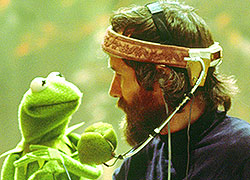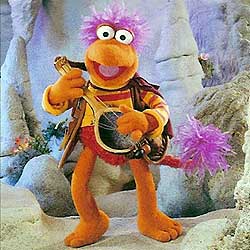I like to copy the articles directly to the thread...
Borne in Effigy
If Protest Is Theater, Its Biggest Actors Are Puppets
By Philip Kennicott
Washington Post Staff Writer
Monday, March 17, 2003; Page C01
Near the front of the tens of thousands of antiwar marchers heading north on 17th Street Saturday was a gauzy Madonna (with dead child), the mother's body mounted on a shopping cart, her arms manipulated with broomsticks. Shortly after came a bulbous-headed George W. Bush, with a hawkish beak of a nose and a bomb cradled in his right hand. And then a weeping woman, an image borrowed from Picasso's "Guernica," her head craned back at a painfully impossible angle, her mouth open as if she's catching raindrops and screaming at the sky simultaneously.
If not a huge display of puppetry, it was a representative one. The Madonna belongs to Marianne Ross, a puppetmaker from Bethesda who works regularly with the granddaddy of political puppet companies, the Vermont-based Bread and Puppet Theater. The Guernica puppet was made by the husband-and-wife team of Marco Giammetti and Carol Hendrickson from Freehold, N.J. It harks back, says Giammetti, to the European tradition of large masks and puppets used during Carnival celebrations. And the George Bush figure was made by a guy from Bryn Mawr, Pa., with no particular background in the form.
"My daughter told me to do a puppet," says Hank Wilson, holding Bush low around the president's magenta, gray and yellow camouflage pattern drapery that forms its midriff. "Because it's fun."
There is a renaissance of political puppetry, according to amateur and professional practitioners alike. Since 1999, when protests against the World Trade Organization in Seattle prominently featured huge puppets (and a good deal of heavily televised mayhem), puppets -- and large effigies and masks -- have become part of the essential vernacular of protest. Established companies bring them by the truckload to prominent marches. Loose networks of "puppetistas" have posted manifestos on the Web. And everywhere there is the homemade product.
The puppets seen Saturday were ambivalent objects -- both festive and threatening -- and like so much of the iconography of the peace movement, they inspire ambivalent reactions. If a new war in Iraq is like the last one, then tens of thousands of young Iraqi men will be shredded by flying metal, incinerated and bulldozed into trenches. The puppet, bobbing above a sea of drumming circles and Mardi Gras costumes, seems at first a woefully inadequate -- and decidedly silly -- symbol.
But that's the view from outside. Within the puppet world, they are a kind of answer, a riposte, to the criticism that has bedeviled the new era of political protest, whether it's anti-globalism or anti-imperialism. The short list of carps: that protest has become a babble of messages with no coherence; that it reflects an impotent nostalgia for the more meaningful resistance of the 1960s; that it lacks intellectual gravitas.
The puppet, however, is about ideas, say puppeteers, even those who make their living doing theater for paying audiences. Unlike other performing arts, especially the high arts, having an overtly political message doesn't put the puppeteer on the radical fringe of the puppet community. Political protest is a perfectly legitimate part of the form.
The large puppet, say an Uncle Sam dripping blood from his lips, clutching a bundle of missiles and lumbering grotesquely in the wind, is, of course, a throwback to the 1960s. But, according to John Bell, a puppeteer and assistant theater professor at Emerson College in Boston, it is not a simple, atavistic throwback to the Vietnam era.
"People will say, oh, this is like the '60s," says Bell. "It is the '60s, but it is also the '40s, the '30s, the '20s, the 1890s and the 18th century. They are connected to a very strong tradition."
That tradition, says Bell, runs back through anti-Nazi demonstrations in New York in the 1930s, to celebrations of Carnival in the Middle Ages, and further, at least to the Greeks, who used to carry huge phallic symbols through the streets to inaugurate theater festivals. He rattles off a long multicultural list of festivals and dramatic forms that have involved puppets (and masks and processional theater), from the Indian Ram Lila to the Iranian Ta'zieh. It isn't just that human beings have been making inanimate representations of living beings for millennia. They have been doing it (very often) to express a worldview that is anti-authoritarian, often licentious and filled with paradox.
"Puppets are discomforting, puppets are weird, puppets are bringing dead materials like paper, wood, plastic to life," says Bell. "And there is something odd and mystical and spiritual about that."
Bill Severnsen, who accompanied the George Bush puppet from Bryn Mawr, speaks of it affectionately. "Everybody who came with us knows to look for George. It's a rallying point," he says.
There's a whiff of the dizzying paradox of the form in that. People will spend dozens of hours, working together, lovingly crafting an image of the thing they hate ("Well, not hate, I try not to hate anyone," says Severnsen). The large puppet, which looms above the people who made it, reverses a familiar dynamic of theatrical puppetry, the human being pulling the strings or moving the rods of a much smaller creation. The big puppet raises, in visual form, a central question: Who, asks the puppet, is pulling whose strings? It enacts a drama of enfranchisement and frustration.
more...

 Welcome to the Muppet Central Forum!
Welcome to the Muppet Central Forum! Sesame Street moving to Netflix
Sesame Street moving to Netflix Jim Henson Idea Man
Jim Henson Idea Man Back to the Rock Season 2
Back to the Rock Season 2 Bear arrives on Disney+
Bear arrives on Disney+ Sam and Friends Book
Sam and Friends Book